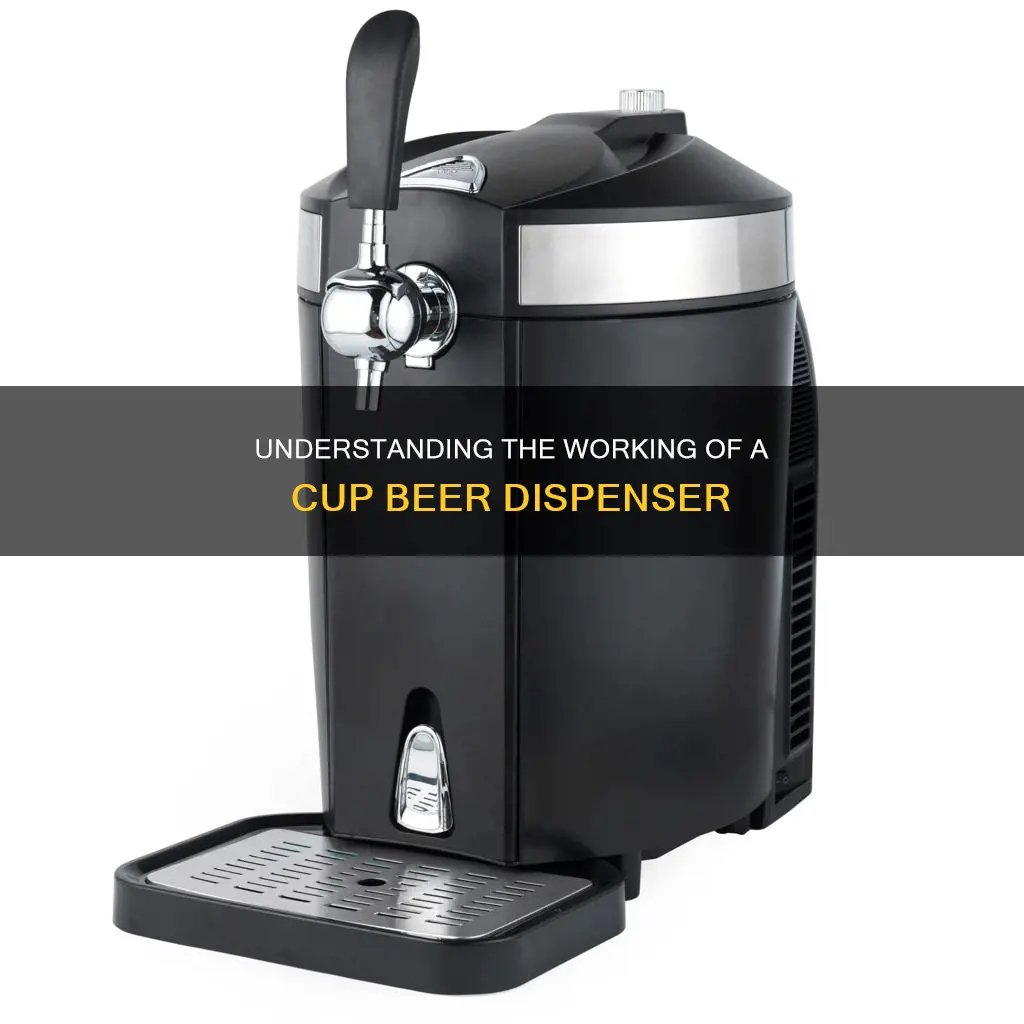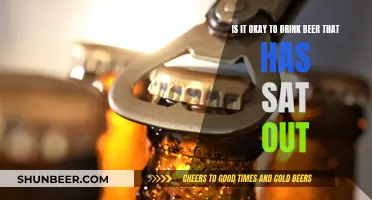
The Bottoms Up Beer Dispenser is a machine that fills cups from the bottom up, reaching speeds of up to 44 pints per minute with a single operator, and 56 pints per minute with multiple operators. The cups have a hole in the bottom with a metal magnetic ring that seals the underside. When placed on the dispenser, the magnets are lifted, allowing beer to be poured without leakage. After dispensing, the cup is removed and the magnet seals the hole. This system offers benefits such as faster pouring, hands-free hygiene, and marketing opportunities, but also has drawbacks, including the cost of the machine and the need for specially made cups.
What You'll Learn
- Kegerators are the most common example of a direct draw draft system
- CO2 or beer gas pushes beer from the keg through the beer line
- A glycol chiller is used when the kegs are not kept refrigerated near the draft tower
- Air-cooled draft systems use chilled air blown through a duct to keep beer cool
- A tap handle is the lever that screws into the draft beer faucet

Kegerators are the most common example of a direct draw draft system
A direct draw beer system is used to deliver draft beer from keg to tap across a short distance. Carbon dioxide or a mixture of nitrogen and CO2, known as beer gas, is used to push the beer from the keg through the beer line to the draft tower and faucet. The refrigeration unit holding the keg also helps to chill the beer as cold air travels up to the draft tower.
Kegerators are available in a range of styles, including single, dual, and triple tap faucets. They can be purchased from brands such as Marvel, Perlick, and Summit, with prices ranging from around $1,200 to $1,600.
A direct draw draft system is one of three standard systems for dispensing draft beer, the other two being long-draw glycol-cooled and long-draw air-cooled systems.
Topsy Keurig Beer: Brewing Innovation Explained
You may want to see also

CO2 or beer gas pushes beer from the keg through the beer line
To understand how CO2 pushes beer from the keg through the beer line, it's important to know the role of carbon dioxide in the beer-making and dispensing processes.
CO2 is the primary gas used in draft beer dispensing systems to get the beer out of the keg and into your glass. Carbon dioxide is naturally produced during the fermentation process, making it the ideal gas source for dispensing draft beer. By using a CO2 tank filled with pressurised gas, the gas is propelled from the tank through the keg coupler and into the beer line. This forces the beer out of the keg and towards the faucet tap, from which it is dispensed into your glass.
The CO2 tank plays a vital role in this process, and its proper setup and maintenance are crucial. The tank should be certified and re-certified every five years, as per the US Department of Transportation regulations. Additionally, the ideal pressure for most beers dispensed using CO2 is between 10-15 PSI, depending on factors such as carbonation level, beer style, temperature, and altitude.
To ensure a balanced system, it typically takes about eight seconds to fill a pint glass or one minute to pour a gallon of beer. Adjustments can be made to the PSI level to achieve the desired carbonation level and pouring experience.
Furthermore, the use of CO2 helps maintain the quality and integrity of the beer. The brewing industry invests significant efforts and resources into keeping oxygen out of the keg, as the presence of oxygen can negatively affect the aroma, texture, and taste of the beer. By using CO2, the risk of oxygen contamination is minimised, resulting in a better-quality product.
Beer and Ice Cream: A Match Made in Heaven?
You may want to see also

A glycol chiller is used when the kegs are not kept refrigerated near the draft tower
A glycol chiller is used when the kegs are not kept near the draft tower and need to be refrigerated. This is known as a long-draw system, where the chiller is at least 75 feet away from the point of dispense. Glycol chillers are designed for commercial applications where the beer is served in a different place to where it is stored.
A typical glycol power pack draft beer chiller consists of two main components: a refrigeration unit (power pack with a glycol pump) and a trunkline (with glycol lines). The refrigeration unit contains a reservoir of glycol that is pumped through the glycol lines inside the trunkline, which cool the beer lines inside. The trunkline is a combination of beer and glycol lines, bound together with an additional layer for insulation. The glycol lines are colour-coded, with blue for outgoing and red for returning glycol.
The glycol chiller is a reliable device that will maintain the temperature of the draft beer from the walk-in cooler to the beer tower and keep it foam-free. The power of glycol is used to move the beer over longer distances while keeping it cold from keg to tap. Propylene glycol is a non-toxic, food-grade antifreeze that has been used for many years in food-processing systems. It is combined with water to create a chilled mixture that is pumped through the cooling lines, which run parallel to the beer lines.
Krusteaz Buttermilk: The Perfect Beer Batter Base?
You may want to see also

Air-cooled draft systems use chilled air blown through a duct to keep beer cool
Air-cooled draft systems are a cost-effective way to keep beer chilled as it travels from keg to tap. This is achieved by using a forced air blower to push chilled air through a duct that contains the beer lines. The chilled air travels from the cooler to the tower, keeping the beer cool, while the warmer air returns to the cooler through a separate duct. This prevents the beer from becoming warm and foamy and stops bacteria from growing in the lines.
There are two types of air-cooled draft systems: single-duct and double-duct. A single-duct system uses one conduit for transporting air to and from the draft tower. A larger duct, typically 4” in outer diameter (OD), holds two smaller ducts (2” and 3” OD) inside it. The chilled air and beer lines travel through the smallest duct from the cooler to the tower, while the returning air uses the larger inner duct. A single-duct system is recommended for draft runs of 15 feet or less.
The double-duct system, on the other hand, uses two ducts to circulate chilled air. The first duct carries the beer lines and chilled air from the cooler to the tower, and the air then returns to the cooler through a second duct. This system is suitable for draft runs of up to 25 feet.
To ensure the chilled air doesn't escape, the duct is usually made of PVC blower tubing and wrapped with foam insulation. The foam insulation should be half an inch larger than the tubing it covers. This is crucial as the tubing is susceptible to temperature changes in the outside environment.
In addition to the duct system, an air-cooled draft system also requires an air baffle and air separator. These components are mounted inside the base of the draft tower to maintain airflow between the air coming to and from the cooler. The separator connects to the mounting flange, while the baffle fits inside the separator.
An air-cooled draft system is a simple and effective way to keep beer chilled during the dispensing process, ensuring a perfectly poured pint every time.
The Process of Canning Beer: A Step-by-Step Guide
You may want to see also

A tap handle is the lever that screws into the draft beer faucet
A tap handle is a device that helps you pour your beer. It is the lever that screws into the draft beer faucet and helps promote the brand by making it easy to identify what type of beer is available. They come in various shapes and sizes, with each one being used differently depending on the brewery they are from. For example, the standard black tap handle is one of the most recognised and can be found almost anywhere, working with most beer faucets. Black tap handles also make it easier to pour beer from direct draw systems mounted on walls, as bigger tap handles can make this difficult.
Tap handles can be purchased wherever draft beer equipment is sold, such as home brewing stores, online, or at local breweries. They are also available at restaurant and pub distributors. The most popular and convenient place to find beer tap handles is online, with Amazon offering a wide range of options.
When installing a tap handle, it is important to follow the correct procedure. First, turn off the beer dispenser or shut off the keg to prevent any beer from spilling or pressure build-up. Next, remove the old tap handle by unscrewing it. Clean the tap handle receiver or connection point on the faucet to remove any dirt or residue. Then, align the screw holes on the new tap handle with the receiver on the faucet and insert the screws. Tighten the screws until the tap handle is securely attached. Finally, turn on the beer dispenser or reopen the keg to resume normal operation.
To remove a stuck tap handle, turn off the water supply to avoid accidental leakage or damage. Apply a lubricant around the base of the tap handle where it meets the valve stem and wait a few minutes. Use a pair of adjustable pliers or a wrench to firmly grip the tap handle and apply gentle but firm pressure with a slow, steady motion to try and break the seal. If this doesn't work, try using a wrench for additional leverage by inserting it near the base of the handle and gently rotating it.
Beer Left Outside: Still Refreshing or a Disaster?
You may want to see also
Frequently asked questions
The glasses have a hole in the bottom with a floppy fridge magnet inside, which sticks to a metal ring surrounding the hole. When the cup is placed on the dispenser, the magnet is pushed up, breaking the seal, and beer is allowed to flow into the cup. When the cup is removed, the magnet falls back into place, sealing the hole.
A single person operating an under-cup beer dispenser can pour up to 44 pints per minute. With multiple people, this can increase to 56 pints per minute, or almost one per second.
Under-cup beer dispensers are fast, can be operated by anyone, and allow bartenders to multitask. They also offer hands-free hygiene, as the beer is dispensed from the bottom of the cup without the need for a nozzle, reducing the risk of cross-contamination.







